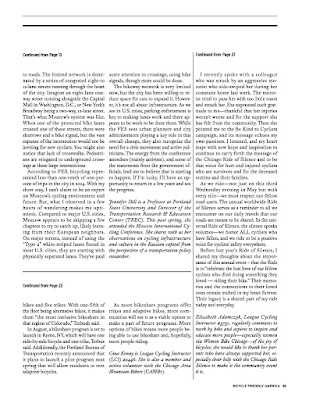This article was originally published by the League of American Bicyclists in the Fall 2016 issue of Bicycle Friendly America.
The vast majority of bicycles used in bikeshare
programs are two-wheeled cruiser bikes, such as those used by Citi Bike, Divvy
and others. Recently, bikeshare programs are originating with alternative and
adaptive bikes as part of their fleets.
The largest, and perhaps most well-known, bikeshare
program with adaptive bikes is at Ohio State University, which started their
bikeshare last fall. “Adaptive bikes have been part of the bicycle fleet since
the bikeshare program began,” said Nicole Holman, Assistant Director of Marketing
and Communications at OSU. “We felt that everyone should have the opportunity
to use the bikeshare program on campus.”
OSU’s program has 115 bikes, with a total of 15 alternative
bikes, including trikes, handcycles, and side-by-side bikes. The most popular
of the alternative bikes are the side-by-side bikes, which could be “used by a
blind or visually impaired rider who wants to go for a bike ride with a friend
or by riders who wish to cycle next to each other on the same bike,” Holman
says. “There have been over 600 rides on these five side-by-side bicycles, or
about 125 rides per bike, since the program began.”
OSU was not the first to decide to have bikes besides
the typical two-wheeled cruisers in a bikeshare program. Carmel, IN launched a
bikeshare program in April 2015, with regular cruiser bikes but also trikes. “When
we started our discussions of bike share, we wanted to include tricycles with
those first two stations so people of all abilities could enjoy our program,”
said David Littlejohn, Alternative Transportation Coordinator for Carmel.
Carmel now has a total of eight tricycles as part of
the bike fleet. The community has found that the trikes are popular with “a
wide array of people;” in particular, the community’s senior population as well
as “people who may not necessarily be in great shape but want to get out,”
Littlejohn said.
One reason so few large bikeshare programs are
offering adaptive bikes is that the majority of the programs have stations
where the bikes are docked. A trike or adaptive bike would need a different
sized station.
The majority of the bikeshare programs with trikes or
adaptive bikes are using Zagster, a Cambridge, MA, Company that provides bikes,
technology and other services for bikeshare programs. One thing that makes
adding alternative bikes to Zagster’s bikeshare fleets easier is that docking
stations are not used, Communications Manager Jon Terbush said.
Scarcity of bikeshare providers that have trikes and
adaptive bikes in their fleets is a larger issue. B-Cycle, in Boulder, did an
internal pilot of a trike in late 2014. Staff, however, felt the trike they
used was somewhat unstable and gave them a feeling that it would be “prone to
tipping,” marketing and communications director Kevin Bell said.
If the company handling the bikeshare program does not
offer alternative bikes, it is very difficult for a community’s bikeshare
program to offer a handcycle, for instance.
An exception to this is in Boston. The Hubway bikeshare
program has more than 1,500 bikes. People can also request a recumbent tricycle,
but, it is rarely used, said Najah Casimir, Program Manager at Boston Bikes.
However, Casimir said, people you may have initially thought that they would
need an adaptive bike have been able to use Hubway’s regular bikes. “It has
been extra educational for us that people of various abilities have been able
to use the upright bike,” said Vineet Gupta, Director of Policy and Planning
for the Boston Transportation Department.
Still, there are people with disabilities or other issues
that prevent them from using the typical bicycle used in bikeshare programs. Trikes
and other adaptive bikes offer an option for them to also enjoy the benefits of
bikeshare.
This year has seen the launch of several programs with
alternative and adaptive bikes and the trend is likely to continue. Bikeshare
programs in College Park, MD, Corvallis, OR, and Westminster, CO, have all
recently launched with trikes and/or adaptive bikes.
The mBike program in the city of College Park and
University of Maryland launched this May with 120 bikes and five alternative
bikes, including side-by-side bikes, trikes and handcycles. “We wanted a system
that was going to be a transportation alternative for the widest possible
audience,” said Aaron Goldbeck, Bicycle Coordinator for the University of
Maryland. They also felt that, if someone was considering buying an adaptive
bike like a handcycle, that they could use the bikeshare program to demo a bike
first, Goldbeck said.
The bikeshare program in Westminster has a total of 40
bikes, with eight of them alternative bikes, including three handbikes and five
trikes. With one-fifth of the fleet being alternative bikes, it makes them “the
most inclusive bikeshare in that region of Colorado,” Terbush said.
In August, a bikeshare program is set to launch in
Rome, NY which will have one side-by-side bicycle and one trike, Terbus said. Additionally,
the Portland Bureau of Transportation recently announced that it plans to
launch a pilot program next spring that will allow residents to rent adaptive
bicycles.
As more bikeshare programs offer trikes and adaptive
bikes, more communities will see it as a viable option to make a part of future
programs. More options of bikes means more people being able to use bikeshare
and, hopefully, more people riding.
Gina Kenny is League Cycling Instructor (LCI) #2446. She is also a member and active volunteer with the Chicago Area Mountain Bikers (CAMBr).




No comments:
Post a Comment